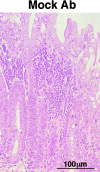Alteration of interleukin 4 production results in the inhibition of T helper type 2 cell-dominated inflammatory bowel disease in T cell receptor alpha chain-deficient mice
- PMID: 10477546
- PMCID: PMC2195615
- DOI: 10.1084/jem.190.5.607
Alteration of interleukin 4 production results in the inhibition of T helper type 2 cell-dominated inflammatory bowel disease in T cell receptor alpha chain-deficient mice
Abstract
T cell receptor alpha chain-deficient (TCR-alpha(-/-)) mice are known to spontaneously develop inflammatory bowel disease (IBD). The colitis that develops in these mice is associated with increased numbers of T helper cell (Th)2-type CD4(+)TCR-betabeta (CD4(+)betabeta) T cells producing predominantly interleukin (IL)-4. To investigate the role of these Th2-type CD4(+)betabeta T cells, we treated TCR-alpha(-/-) mice with anti-IL-4 monoclonal antibody (mAb). Approximately 60% of TCR-alpha(-/-) mice, including those treated with mock Ab and those left untreated, spontaneously developed IBD. However, anti-IL-4 mAb-treated mice exhibited no clinical or histological signs of IBD, and their levels of mucosal and systemic Ab responses were lower than those of mock Ab-treated mice. Although TCR-alpha(-/-) mice treated with either specific or mock Ab developed CD4(+)betabeta T cells, only those treated with anti-IL-4 mAb showed a decrease in Th2-type cytokine production at the level of mRNA and protein and an increase in interferon gamma-specific expression. These findings suggest that IL-4-producing Th2-type CD4(+)betabeta T cells play a major immunopathological role in the induction of IBD in TCR-alpha(-/-) mice, a role that anti-IL-4 mAb inhibits by causing Th2-type CD4(+)betabeta T cells to shift to the Th1 type.
Figures











References
-
- Powrie P. T cells in inflammatory bowel diseaseprotective and pathogenic roles. Immunity. 1995;3:171–174. - PubMed
-
- Mombaerts P., Mizoguchi E., Grusby M.J., Glimcher L.H., Bhan A.K., Tonegawa S. Spontaneous development of inflammatory bowel disease in T cell receptor mutant mice. Cell. 1993;75:274–282. - PubMed
-
- Strober W., Ehrhardt R.O. Chronic intestinal inflammationan expected outcome in cytokine or T cell receptor mutant mice. Cell. 1993;75:203–205. - PubMed
-
- Sadlack B., Merz H., Schimpl A., Feller A.C., Horak I. Ulcerative colitis-like disease in mice with a disrupted interleukin-2 gene. Cell. 1993;75:253–261. - PubMed
Publication types
MeSH terms
Substances
LinkOut - more resources
Full Text Sources
Other Literature Sources
Molecular Biology Databases
Research Materials

